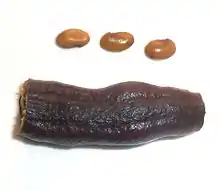Bobgunnia madagascariensis
Bobgunnia madagascariensis (Bambara: samagara), also called the snake bean plant,[2] is a species of legume in the family Fabaceae.
| Bobgunnia madagascariensis | |
|---|---|
 | |
| Pod fragment and seeds | |
| Scientific classification | |
| Kingdom: | Plantae |
| Clade: | Tracheophytes |
| Clade: | Angiosperms |
| Clade: | Eudicots |
| Clade: | Rosids |
| Order: | Fabales |
| Family: | Fabaceae |
| Subfamily: | Faboideae |
| Genus: | Bobgunnia |
| Species: | B. madagascariensis |
| Binomial name | |
| Bobgunnia madagascariensis | |
| Synonyms[1] | |
| |
Description
Bobgunnia madagascariensis is a small deciduous tree, 3–4 m tall. The plant has large pods that turn dark when ripe.[2]
Ecology
The larvae of Abantis zambesiaca feed on B. madagascariensis.
Toxicity
Bobgunnia madagascarensis is toxic.[3]
Applications

Poison composed of the roasted seeds of Bobgunnia madagascariensis and innards of the beetle Diamphidia nigroornata is applied to the arrows of the Bushmen. Seeds, fruits and stem bark are also used in fishing by poisoning in Africa.[4]
Chemistry
The methanolic extract of the fruit of B. madagascariensis contains a saponin tetraglycoside.[5]
The root bark of B. madagascariensis contains quinone methide diterpenes.[6]
The seed pod contains two acidic saponins, swartziasaponin A and B and swartziagenin, a mixture of oleanolic and O-acetyloleanolic acid.[7] The pod methanolic extract yields highly glycosylated flavonoids (glycosides of kaempferol and quercetin).[8]
The crude chloroform and methanol extracts of the stem bark of the plant show strong feeding deterrent activity against stored-product insect pest of maize Tribolium castaneum with the two compounds, methyl paraben and lupeol, being identified in these extracts.
Other compounds in B. madagascariensis are (−)-maackiain, (−)-medicarpin, gypsogenin 3-O-rhamnosylglucuronide, (−)-homopterocarpin, pterocarpin, 4-methoxymedicarpin, 4-methoxymaackiain, 4-methoxyhomopterocarpin, 4-methoxypterocarpin, anhydrovariabilin and coumestrol dimethyl ether.[9]
References
- "The Plant List".
- Hyde, M. A.; Wursten, B. T.; Ballings, P.; Coates Palgrave, M. (2015). "Bobgunnia madagascariensis (Desv.) J.H. Kirkbr. & Wiersama". Flora of Zimbabwe. Retrieved 4 December 2015.
- Perchman, GE (1978). "Toxicity of Swartzia madagascarensis Desv". Journal of the South African Veterinary Association. 49 (4): 362. PMID 752087.
- Neuwinger, H.D. (2004). "Plants used for poison fishing in tropical Africa". Toxicon. 44 (4): 417–30. doi:10.1016/j.toxicon.2004.05.014. PMID 15302524.
- Wolfender, J.-L; Rodriguez, S; Hostettmann, K (1998). "Liquid chromatography coupled to mass spectrometry and nuclear magnetic resonance spectroscopy for the screening of plant constituents". Journal of Chromatography A. 794: 299. doi:10.1016/S0021-9673(97)00939-4.
- Schaller, Frédéric; Wolfender, Jean-Luc; Hostettmann, Kurt; Mavi, Steven (2001). "New Antifungal 'Quinone Methide' Diterpenes fromBobgunnia madagascariensis and Study of Their Interconversion by LC/NMR". Helvetica Chimica Acta. 84: 222. doi:10.1002/1522-2675(20010131)84:1<222::AID-HLCA222>3.0.CO;2-R.
- Jewers, K.; Coker, R.D.; Dougan, J.M.; Sandberg, F. (1971). "Swartziagenin: A mixture of oleanolic and O-acetyloleanolic acids". Phytochemistry. 10 (9): 2263. doi:10.1016/S0031-9422(00)97243-1.
- Stevenson, Philip C.; Nyirenda, Stephen P.; Veitch, Nigel C. (2010). "Highly glycosylated flavonoids from the pods of Bobgunnia madagascariensis". Tetrahedron Letters. 51 (36): 4727. doi:10.1016/j.tetlet.2010.07.013.
- "KNApSAcK keyword Search". kanaya.naist.jp. Archived from the original on 2014-12-13. Retrieved 2017-08-04.